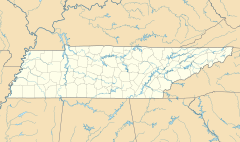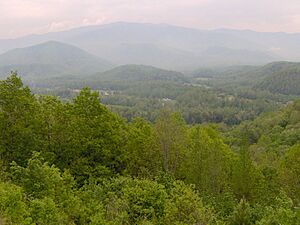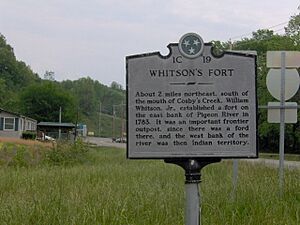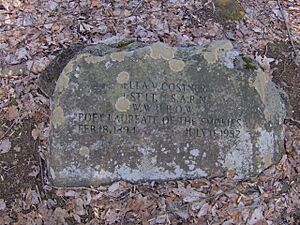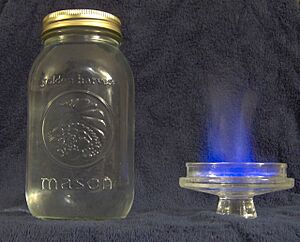Cosby, Tennessee facts for kids
Quick facts for kids
Cosby, Tennessee
|
|
|---|---|
| Cosby | |
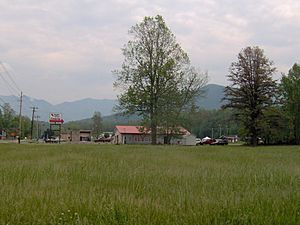
Cosby area
|
|
| Country | United States |
| State | Tennessee |
| County | Cocke |
| Area | |
| • Total | 5.53 sq mi (14.33 km2) |
| • Land | 5.53 sq mi (14.33 km2) |
| • Water | 0.00 sq mi (0.00 km2) |
| Elevation | 1,723 ft (525 m) |
| Population
(2020)
|
|
| • Total | 807 |
| • Density | 145.85/sq mi (56.31/km2) |
| Time zone | UTC-5 (Eastern (EST)) |
| • Summer (DST) | UTC-4 (EDT) |
| ZIP codes |
37722
|
| FIPS code | 47-17300 |
| GNIS feature ID | 2813075 |
Cosby is a small community in Cocke County, Tennessee. It's known as a census-designated place (CDP), which means it's a specific area identified by the census bureau for statistics. In 2020, about 807 people lived in the Cosby CDP. This community is famous for being next to the northeastern part of the Great Smoky Mountains National Park. Its zip code also reaches into Sevier County.
Contents
Who Lives in Cosby?
Cosby is a small community with a unique mix of people. In 2000, about 5,201 people lived in the larger area covered by Cosby's zip code (37722). Most residents were White (98.8%). A small number were Native American, Asian, or African American. About 0.9% of the population identified as Hispanic or Latino.
Many households in Cosby were families. About 56.8% were married couples living together. Some households (31.3%) had children under 18. The average age in the area was around 38 years old.
Exploring Cosby's Geography
Cosby is located on the edge of the Great Smoky Mountains. It sits in a narrow valley. This valley stretches from Newport in the north to the national park in the south. English Mountain rises high to the northwest. Green Mountain is to the east. The Great Smoky Mountain National Park forms Cosby's southern border.
Cosby Creek and Its Path
Cosby Creek is the main waterway in the valley. It starts high up in the Smokies near Cammerer Ridge. The creek flows through the valley, following Tennessee Route 32/U.S. Route 321. It then turns east near Allen Grove. Finally, it empties into the Pigeon River.
Sections of Cosby
Cosby has traditionally been divided into three parts based on elevation. These are "Lower Cosby," "Middle Cosby," and "Upper Cosby."
- Lower Cosby is the northernmost section. It's near where Cosby Creek meets the Pigeon River.
- Upper Cosby is mostly inside the national park now. It's close to the Cosby Campground.
Main Roads in Cosby
U.S. Route 321 is the main road. It connects Cosby to Newport (about 10 miles north). It also goes to Gatlinburg (about 20 miles west). Another road, TN-339, connects Cosby to Jones Cove and Sevierville to the west. The Foothills Parkway also meets US-321 nearby. TN-32 runs alongside US-321. It then goes east into the national park.
A Look Back at Cosby's History
Cosby has a rich history, especially tied to the mountains.
Early Days and First Settlers
For many years, the Cherokee people used the lands around the Great Smokies for hunting. The first European settlers arrived in the 1780s. Samuel Odell was likely the first to settle in the Cosby Creek valley.
Early settlers faced challenges. To protect themselves, William Whitson built a small fort. This fort was near where Cosby Creek meets the Pigeon River. It grew into a small outpost. By the early 1800s, the Cosby area became more peaceful.
Where Did the Name "Cosby" Come From?
The exact origin of the name "Cosby" is a bit of a mystery. One idea is that it came from an early trapper and distiller named Jonathan Cosby. Another idea suggests it was named after Dr. James Cozby. He was a veteran of the American Revolutionary War and a friend of John Sevier. He might have claimed land along the creek. The name "Cosby Creek" was first mentioned in church records in 1838.
Cosby During the Civil War
During the American Civil War, people in Cocke County, like many in East Tennessee, had mixed feelings. Some supported the Union, and others supported the Confederate side. Cosby, being a mountain community, faced raids during the war. A "home guard" camp was set up to help protect the area.
After the war, Cosby slowly began to recover. The community benefited from new railroad stations built nearby in the late 1800s. A lumber mill also opened in Hartford in the 1890s.
Life in Early 1900s Cosby
By 1900, most Cosby residents were farmers or worked in lumber mills. Some also gathered plants like ginseng from the mountains to earn money. Making homemade corn liquor was also a way for some to supplement their income. Religion was very important to the community.
Church services were often held once a month. Mary Bell Smith, who grew up in Cosby in the 1920s, remembered the sermons. She said preachers would describe Heaven and Hell. Churches usually didn't have instruments, so everyone sang together.
Education was simple back then. Most children went to small, one-room schoolhouses. Mary Bell Smith described her school:
The one-room school building was only about thirty by fifty feet and rested on stone pillars about four feet off the ground at the front entrance. Inside a chalk-board stretched across the back wall, and a pot-bellied stove stood near the center of the room. A water bucket, a tin dipper, six erasers, and a broom completed the educational supplies.
When the Great Depression hit, many sawmills closed. Farmers found it hard to sell their crops. Some people turned to making and selling unlicensed liquor to survive. Many mountain families relied on their hunting skills during this tough time. Help arrived when the Civilian Conservation Corps set up a camp. They built trails for the new Great Smoky Mountains National Park. The TVA also started building Douglas Dam nearby.
Unlike some other mountain communities, only part of Cosby became part of the national park. Many farmers were happy to sell their land. But for others, it was sad to leave their homes.
Making Homemade Liquor in Cosby
For a long time in the early 1900s, Cosby was known for making homemade corn liquor without licenses. This was often called "moonshine." Corn was a main crop in Cosby. However, the soil in the hilly areas became poor over time. Farmers struggled to make enough money. So, they started making and selling liquor to earn extra income.
The hidden coves and thick forests of the Smokies were perfect for these activities. During prohibition (when alcohol was banned), the demand for this homemade liquor grew. Cosby was connected by road to larger towns, which gave it an advantage. Also, Cosby didn't attract as much tourism as other towns like Gatlinburg. This led to more people in Cosby making and selling unlicensed liquor.
During World War II, many people moved to Oak Ridge for the Manhattan Project. They often bought this homemade liquor. This increased the demand even more. People making liquor even used a government program for beehives to get sugar, which was in short supply during the war.
Law enforcement tried to stop these activities. People in Cosby would warn each other when agents were coming. They would even set off dynamite as a signal. Locals would sometimes follow agents' cars to alert others. It was hard for law enforcement to get help from Cosby residents. People making liquor found many ways to avoid being caught. Mary Bell Smith remembered seeing people brush away tire tracks with pine branches. She also saw a place where liquor was being made in plain sight of a church.
Over time, the practice of making unlicensed liquor decreased. This happened as laws changed in different counties. While most Cosby residents were law-abiding, the town's past reputation for making liquor still lingers today.
Cosby Today
In 2020, the United States Census Bureau officially recognized Cosby as a census-designated place.
Cosby's Economy
Cosby's economy is largely supported by the Great Smoky Mountains National Park and the Foothills Parkway. It's known as a peaceful, country town. It's different from its larger neighbor, Newport, Tennessee. Cosby attracts many visitors and tourists, especially from the Gatlinburg and Pigeon Forge areas. The community has motels, cabins, and country-style restaurants. This helps support its small, mountain town feel.
Schools in Cosby
Children in the Cosby community attend schools in either the Cocke County Schools System or the Sevier County Schools System.
Cocke County Schools
- Cosby Elementary School: This school serves students from Kindergarten to 8th grade. It's connected to the high school.
- Cosby High School: This school is for grades 9-12. Their mascot is the "Eagles." The school has strong sports teams, including basketball, football, softball, baseball, volleyball, and soccer. Their basketball teams have done very well in state tournaments.
- Smoky Mountain Elementary School: This school serves students from Pre-Kindergarten to 8th grade.
Sevier County Schools
- Jones Cove Elementary School: This school serves students from Pre-Kindergarten to 8th grade.
- Pittman Center Elementary School: This school serves students from Pre-Kindergarten to 8th grade.
- Gatlinburg-Pittman High School: This school is for grades 9-12.
Notable People from Cosby
- Ken Arensbak: A well-known lithographer and artist.


